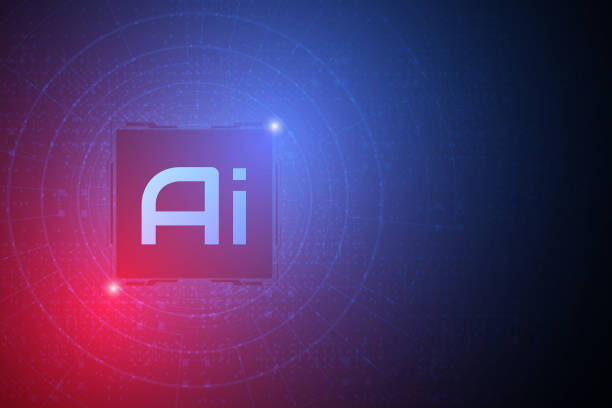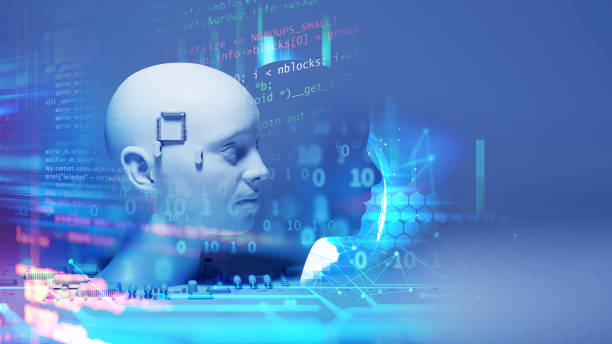What is an AI Robot and How Does it Work?

What is an AI Robot and How Does it Work?
#AI Robot is a combination of two important fields of technology: #Artificial Intelligence and #Robotics.
Simply put, an AI robot is a physical or virtual robot controlled by artificial intelligence algorithms.
These robots are capable of performing tasks that require intelligence, comprehension, and decision-making, just like humans.
Artificial intelligence enables the robot to collect, analyze, and act upon data.
These algorithms can include Machine Learning, Natural Language Processing, and Computer Vision.
For example, an AI robot in a factory can use computer vision to detect defective parts and remove them from the production line.
Or a customer service robot can use natural language processing to answer customer questions and resolve their issues.
The main difference between traditional robots and AI robots lies in their flexibility and adaptability to various conditions.
Traditional robots are usually programmed for repetitive and specific tasks and cannot react well to environmental changes.
Whereas AI robots can improve their performance by learning from their experiences and making independent decisions.
AI robots have widespread applications in various industries, including manufacturing, healthcare, customer service, and agriculture.
Did you know that 94% of users’ first impressions of a business are related to its website design? With professional corporate website design by **Rasawweb**, turn this first impression into an opportunity for growth.
✅ Attract more customers and increase sales
✅ Build credibility and trust in the eyes of the audience⚡ Get a free website design consultation!
Main Components of an AI Robot

Main Components of an AI Robot
An AI robot consists of several key components that work together to enable the performance of intelligent tasks:
- Sensors Sensors collect information about the surrounding environment.
This information can include temperature, light, sound, image, or pressure. - Processors Processors process the information collected by sensors and make decisions based on AI algorithms.
- Actuators Actuators execute processor commands, enabling the robot to move in the environment, manipulate objects, or interact with humans.
- AI Software AI software includes machine learning, natural language processing, and computer vision algorithms that allow the robot to act intelligently.
For example, a self-driving robot uses sensors such as cameras, lidar, and radar to collect information about its surroundings.
Then, processors process this information and determine the vehicle’s path.
Actuators (motors and steering system) execute the processor’s commands and guide the vehicle along the determined path.
AI software improves the vehicle’s performance by learning from driving experiences, allowing it to operate safely in various driving conditions.
The AI robot plays a very important role in this scenario, enabling the vehicle to move without human intervention.
To purchase a virtual server, you can refer to reputable websites.
Diverse Applications of AI Robots in Various Industries

Diverse Applications of AI Robots in Various Industries
AI robots have widespread applications in various industries and are transforming the way we work and live.
Some of the most important applications of AI robots include:
Manufacturing AI robots can be used in production lines to perform repetitive and dangerous tasks.
They can assemble parts, package products, and check their quality with high precision and speed.
AI robots in this industry lead to increased productivity and reduced costs.
Healthcare AI robots can assist doctors and nurses in diagnosing diseases, performing surgeries, and caring for patients.
They can analyze medical images, detect anomalies, and help doctors determine the best treatment method.
Additionally, surgical robots can perform complex surgeries with high precision and delicacy.
Customer Service AI robots (chatbots) can answer customer questions, resolve their issues, and provide guidance.
These robots can be available 24/7 and respond quickly to a large volume of requests.
AI robots in this area improve customer experience and reduce customer service costs.
| Industry | AI Robot Application | Benefits |
|---|---|---|
| Manufacturing | Part assembly, product packaging, quality inspection | Increased productivity, reduced costs, improved quality |
| Healthcare | Disease diagnosis, surgical procedures, patient care | Improved diagnostic accuracy, increased treatment speed, reduced medical errors |
| Customer Service | Answering customer questions, resolving issues, guidance | Improved customer experience, reduced service costs, 24/7 access |
Challenges and Limitations of AI Robots

Challenges and Limitations of AI Robots
Despite significant advancements in the field of AI robots, there are still challenges and limitations that need to be addressed:
- Cost The design, construction, and maintenance of AI robots are usually expensive.
This cost can be an obstacle to the widespread use of this technology in some industries. - Complexity Developing and programming AI robots requires high expertise and technical knowledge.
Also, these robots typically consist of complex systems that are difficult to maintain and troubleshoot. - Security AI robots can be vulnerable to cyberattacks.
Hackers can infiltrate the control systems of robots, disable them, or even use them for malicious purposes. - Ethics The use of AI robots raises important ethical questions.
For example, if a self-driving robot causes an accident, who will be responsible? Or is it ethical to use AI robots to replace human labor?
To overcome these challenges, investment in research and development, training of specialized personnel, and the establishment of appropriate laws and regulations are necessary.
By solving these challenges, the high potential of AI robots can be leveraged to improve human lives and advance societies.
AI robots require continuous review and development to fully serve humanity.
Research shows that 80% of customers trust companies with professional websites more. Does your current website inspire this trust?
With Rasawweb’s corporate website design services, permanently solve the problem of customer distrust and a weak online image!
✅ Create a professional image and increase customer trust
✅ Generate more sales leads and grow your business
⚡ Get a free consultation!
Machine Learning, the Beating Heart of AI Robots

Machine Learning, the Beating Heart of AI Robots
Machine Learning is one of the most important subfields of artificial intelligence that enables robots to learn from data and improve their performance without explicit programming.
In fact, machine learning provides AI robots with the ability to acquire new knowledge and make better decisions through experience.
Machine learning algorithms enable robots to identify patterns and relationships in data and use them for prediction, decision-making, or problem-solving.
For example, an AI robot designed to diagnose skin diseases can use machine learning algorithms to learn from thousands of images of healthy and diseased skin, gradually increasing its accuracy in diagnosing diseases.
In this scenario, the AI robot acts like a specialist doctor who enhances their knowledge through experience.
There are various types of machine learning algorithms, each suitable for specific applications.
Some of the most important types of machine learning include: Supervised Learning, Unsupervised Learning, and Reinforcement Learning.
The choice of the appropriate algorithm depends on the type of data and the goal that the AI robot needs to achieve.
Natural Language Processing, Key to Human-Robot Interaction

Natural Language Processing, Key to Human-Robot Interaction
Natural Language Processing (NLP) is a branch of artificial intelligence that enables robots to understand, interpret, and respond to human language.
NLP gives AI robots the ability to communicate with humans in natural language (such as Persian or English) and execute their commands.
NLP uses various algorithms to analyze and understand human language.
These algorithms can include Syntax Analysis, Semantic Analysis, and Pragmatic Analysis.
By using these algorithms, the AI robot can understand the structure and meaning of sentences and discern the speaker’s intent.
The applications of NLP in AI robots are very broad.
For example, customer service robots can use NLP to answer customer questions and resolve their issues.
Home robots can use NLP to receive voice commands and control household appliances.
And educational robots can use NLP to help students learn foreign languages.
NLP transforms the AI robot into a true colleague and assistant for humans.
Computer Vision, the Eyes of AI Robots
![]()
Computer Vision, the Eyes of AI Robots
Computer Vision is a branch of artificial intelligence that enables robots to understand images and videos and extract useful information from them.
Computer Vision gives AI robots the ability to see and understand the world around them, just like humans.
Computer Vision uses various algorithms to process images and videos.
These algorithms can include Object Detection, Face Detection, Motion Detection, and Scene Analysis.
By using these algorithms, the AI robot can identify objects in an image, recognize faces, track the movement of objects, and generally understand the scene.
The applications of computer vision in AI robots are very diverse.
For example, self-driving robots can use computer vision to detect obstacles in their path and prevent accidents.
Industrial robots can use computer vision to identify defective parts and remove them from the production line.
And security robots can use computer vision to detect the faces of suspicious individuals and alert security forces.
An AI robot, using computer vision, can operate autonomously in complex environments.
| Field | Key Algorithms | Applications in AI Robots |
|---|---|---|
| Object Detection | YOLO, Faster R-CNN | Obstacle detection for self-driving robots |
| Face Detection | Haar Cascades, MTCNN | Authentication of individuals in security robots |
| Motion Detection | Optical Flow, Background Subtraction | Tracking object movement in surveillance robots |
The Future of AI Robots: What to Expect

The Future of AI Robots: What to Expect
The future of AI robots is very bright and full of potential.
With continuous advancements in artificial intelligence, robotics, and related technologies, AI robots are expected to play a much more significant role in our lives in the future.
In the future, AI robots will be able to perform more complex tasks, interact more naturally with humans, and operate autonomously in various environments.
They can assist us in homes, hospitals, factories, and even in space.
The AI robot will not only be a tool for performing tasks but also an intelligent colleague and companion for humans.
However, to reach this future, existing challenges and limitations must be overcome, and responsible development and use of AI robots must be ensured.
AI robots should be designed and developed in a way that benefits humanity and helps preserve human values.
Are you tired of your company’s website not meeting your expectations? With Rasawweb, design a professional website that truly represents your business.
✅ Increase new customer acquisition and sales leads
✅ Boost your brand’s credibility and trust with your audience
⚡ Get a free website design consultation!
Important Considerations in Selecting and Using AI Robots
![]()
Important Considerations in Selecting and Using AI Robots
Selecting and using an AI robot requires attention to important points to ensure its optimal performance and safety:
- Define Requirements Before purchasing or designing an AI robot, you must precisely define your needs.
What tasks do you want the robot to perform? What features are important to you? By specifying your needs, you can choose the appropriate robot. - Evaluate Performance Evaluate the robot’s performance before purchasing or using it.
Can the robot perform the desired tasks with sufficient accuracy and speed? Does the robot have learning capabilities and adaptability to different conditions? - Ensure Safety Ensure the robot is safe.
Does the robot have appropriate safety systems to prevent harm to humans and the surrounding environment? Does the robot have valid safety certifications? - Training and Maintenance Provide necessary training to robot users.
How to turn the robot on and off? How to use the robot? How to troubleshoot potential problems? Also, regularly maintain the robot and replace worn parts.
By observing these points, you can use the AI robot safely and effectively and benefit from its advantages.
The AI robot should serve as a powerful tool for humanity and contribute to improving their quality of life.
AI Robots and Their Impact on the Future of Work

AI Robots and Their Impact on the Future of Work
AI robots will have a significant impact on the future of work.
On one hand, robots can perform repetitive, dangerous, and difficult tasks, allowing humans to engage in more creative and complex roles.
AI robots can lead to increased productivity, reduced costs, and improved work quality.
On the other hand, robots can replace human labor, leading to unemployment in some industries.
To address this challenge, there is a need to train the workforce for new skills and create new job opportunities.
AI robots should be used as a tool to assist humans in their work, not as a replacement for them.
Adapting to the changes brought by AI robots requires investment in education and skill development, the creation of supportive policies, and encouragement of innovation.
AI robots can revolutionize the future of work, but this transformation must be managed in a way that benefits all members of society.
AI robots should serve sustainable and equitable development.
Frequently Asked Questions
| Question | Answer |
|---|---|
| What is an AI robot? | It is a robot that uses artificial intelligence capabilities to understand its environment, reason, learn, and make decisions to perform complex tasks autonomously. |
| What is the main difference between a regular robot and an AI robot? | AI robots can learn and adapt to their environment, whereas regular robots typically operate based on fixed, predetermined programming. |
| In what areas are AI robots used? | In fields such as industry (production lines), medicine (robotic surgeries), services (customer support, smart vacuum cleaners), exploration (space and underwater), and entertainment. |
| How do AI robots learn? | They acquire new skills by analyzing large datasets and identifying patterns through Machine Learning and Deep Learning algorithms. |
| Can AI robots have emotions? | Currently, no. They can recognize or simulate emotions, but they do not experience real emotions like humans. |
| What are the main advantages of using AI robots? | Increased productivity, reduced human error, performance of dangerous or repetitive tasks, and provision of innovative and efficient services. |
| What challenges exist in the development of AI robots? | The need for vast and high-quality data, algorithmic complexity, ethical issues, cybersecurity, and high research and development costs. |
| Are AI robots dangerous to humans? | With adherence to safe design principles and ethical regulations, no. Concerns primarily relate to social and economic impacts, such as changes in the job market. |
| What is an example of an AI robot in daily life? | Smart vacuum robots (like Roomba) that automatically map and clean homes, or smart voice assistants (like Siri and Alexa). |
| How is the future of AI robots predicted? | They are expected to become smarter, more autonomous, and capable of more complex interactions with humans, playing a more prominent role in industry, medicine, transportation, and daily life. |
And other advertising services by Rasawweb Advertising Agency:
- Smart Digital Branding: A combination of creativity and technology for digital branding through intelligent data analysis.
- Smart Website Development: A combination of creativity and technology for digital branding through precise audience targeting.
- Smart Conversion Rate Optimization: Transform user engagement by optimizing key pages.
- Smart Advertising Campaign: Professional optimization to attract customers using SEO-driven content strategy.
- Smart Social Media: Designed for businesses looking to increase click-through rates by optimizing key pages.
And over a hundred other services in internet advertising, advertising consultation, and organizational solutions.
Internet Advertising | Advertising Strategy | Advertorials
Resources
What is Artificial Intelligence? (Digiato)
Applications of Robotics and Artificial Intelligence (Zoomit)
The Future of Artificial Intelligence in Iran (Tasnim News Agency)
Smart Robots: Development and Challenges (Vajje)
? Do you want to revolutionize your business in the digital world? Rasawweb Afarin Digital Marketing Agency, with its expertise in WordPress website design, SEO, and content marketing, is your comprehensive solution for online growth and prominence.
📍 Tehran, Mirdamad Street, next to Central Bank, Kazeroon Janubi Alley, Ramin Alley, No. 6


